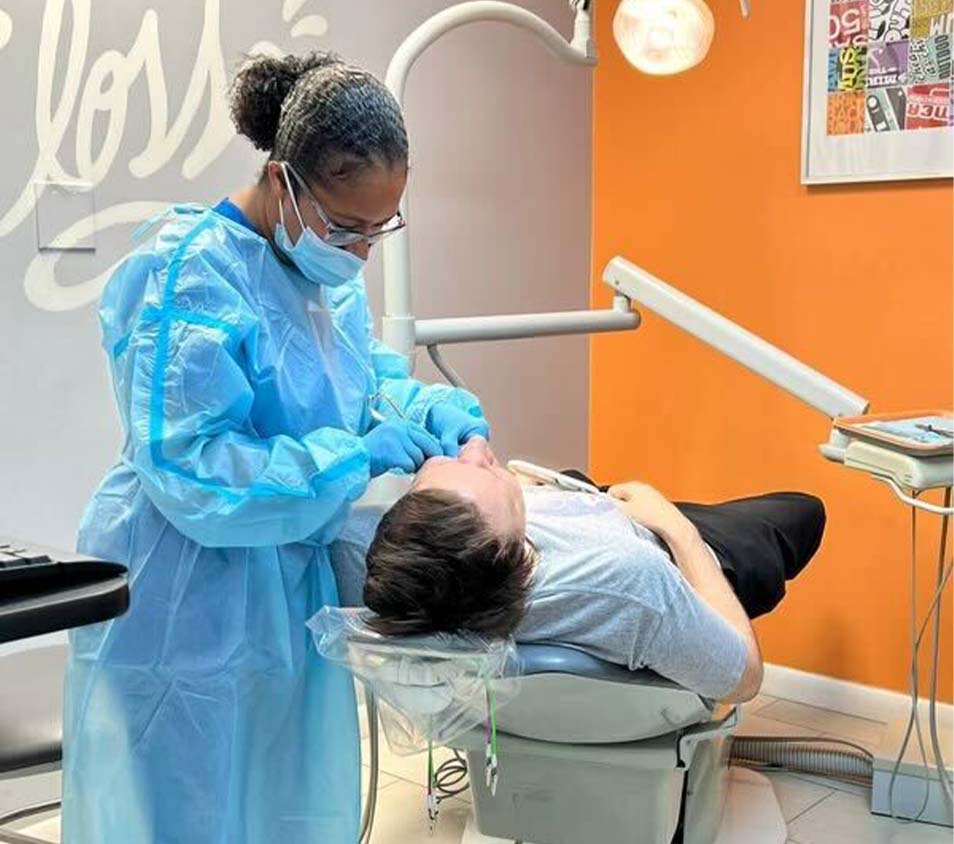Typical Inquiries About Oral Veneers Responded To
Oral veneers have become a progressively desired choice for those seeking to improve their smiles, yet numerous individuals remain unsure regarding different facets of their use. Key concerns typically occur pertaining to the application process, longevity, and prospective threats associated with these cosmetic improvements. Additionally, the difference between porcelain and composite veneers can substantially affect one's selection. As we check out these typical questions, it becomes vital to think about not only the benefits but likewise the effects of choosing dental veneers in pursuit of a much more positive appearance. What elements should one evaluate prior to making such a choice?
What Are Oral Veneers?
Oral veneers are thin, customized coverings crafted from porcelain or composite resin that are created to cover the front surface of teeth. These dental prosthetics offer both visual and practical functions, offering a solution for different dental flaws, including discoloration, chips, gaps, and imbalance. By sticking to the teeth, veneers can dramatically improve the total look of a smile, developing an extra uniform and eye-catching look.
Porcelain veneers are particularly favored for their natural clarity and stain resistance, making them an ideal option for individuals seeking durable results. In contrast, composite material veneers are typically less costly and can be applied in a solitary check out, however they may not offer the very same durability as porcelain choices.
The decision to select dental veneers commonly stems from a wish for aesthetic improvement, yet patients need to also take into consideration variables such as the durability of the material, upkeep demands, and the possible need for tooth reduction (Low Cost Veneers). Eventually, oral veneers represent a flexible and reliable option for achieving a radiant smile, dealing with specific aesthetic demands while advertising self-confidence and self-esteem
How Are Veneers Applied?
The application process for veneers needs careful planning and precision to ensure optimum results. The procedure normally starts with an extensive assessment, where the dentist assesses the person's dental health, talks about preferred end results, and identifies the suitable sort of veneers, whether porcelain or composite material.
When the treatment plan is established, the dental practitioner prepares the teeth by removing a thin layer of enamel, normally concerning 0.5 mm to 1 mm, to fit the veneer. This action is crucial as it guarantees an appropriate fit and avoids the veneers from appearing cumbersome - Low Cost Veneers. After prep work, perceptions of the teeth are taken to develop customized veneers that match the person's one-of-a-kind oral framework and visual preferences
While the long-term veneers are being fabricated in an oral lab, short-lived veneers may be positioned to secure the ready teeth. Once the long-term veneers are all set, the dental practitioner will carefully bond them to the teeth making use of a strong dental adhesive.
What Are the Advantages?

Additionally, veneers are understood for their durability and resistance to tarnishing compared to all-natural teeth. Made from top quality materials such as porcelain or composite material, they can preserve their look for many years with correct care. This durability makes them a functional investment in one's dental appearance.
Along with aesthetic improvements, veneers can also add to improved oral wellness. By covering harmed or compromised teeth, they can offer additional assistance and defense, aiding to avoid further degeneration or degeneration. This safety facet can reduce the requirement for a lot more considerable oral procedures in the future.

How Much Time Do They Last?
With correct treatment and upkeep, dental veneers can last anywhere from 10 to 15 years, making them a durable option for improving one's smile. The durability of veneers mostly depends upon the product made use of, the quality of the first placement, and the person's adherence to dental health methods.
Porcelain veneers his explanation are known for their longevity and resistance to staining, commonly lasting closer to the 15-year mark when cared for suitably. Composite veneers, while a lot more economical, may need substitute earlier, usually within 5 to 10 years because of their sensitivity to use and discoloration.

In addition, using a mouthguard throughout sports or nighttime can supply extra defense. Eventually, while veneers provide a considerable aesthetic improvement, their long life is considerably affected by the dedication to appropriate dental care and regular appointments with an oral professional.
Exist Any Type Of Dangers?
Thinking about the transformative impacts of dental veneers, it is necessary to recognize the prospective threats connected with their application. While veneers can boost the appearance of teeth, the procedure involves the elimination of a thin layer of enamel, which can increase tooth level of sensitivity and vulnerability to decay.
One significant risk is the possibility of incorrect placement or fitting, causing discomfort, bite misalignment, or perhaps damages to the underlying tooth framework. In addition, if the veneers are not kept properly, they can become blemished or cracked over time, demanding replacement.
Individuals might likewise experience allergies to the materials made use of in the veneers, specifically if they have level of sensitivities to particular dental compounds. While veneers are durable, they are not undestroyable; excessive force from grinding or clenching can lead to fractures.
It is crucial for clients to consult with a certified oral professional to examine their specific risks and to adhere to aftercare guidelines faithfully. By comprehending these dangers, patients can make enlightened decisions regarding their oral veneer therapy and make certain the longevity and success of their enhancements.
Conclusion
In summary, oral veneers represent an important cosmetic solution for enhancing smiles, with considerations regarding their application, advantages, longevity, and linked dangers. Ultimately, informed decision-making regarding dental veneers can lead to sufficient aesthetic outcomes and improved oral health and wellness.
Oral veneers are slim, customized shells crafted from porcelain or composite material that about his are created to cover the front surface of teeth. After preparation, impacts of the teeth are taken to produce custom veneers that match the person's distinct dental framework and visual choices.
While the permanent veneers are being made in an oral laboratory, short-lived veneers might be placed to safeguard the ready teeth. As soon as the long-term veneers are prepared, the dental practitioner will carefully bond them to the teeth using a strong dental adhesive. Ultimately, informed decision-making relating to oral veneers can lead to adequate aesthetic end results and enhanced dental wellness.